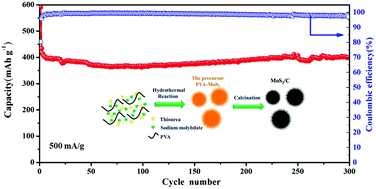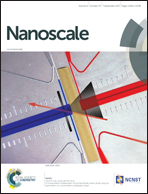Few-layered MoS2/C with expanding d-spacing as a high-performance anode for sodium-ion batteries†
Abstract
Sodium-ion batteries (SIBs) show great potential as alternative energy storage devices for next generation energy storage systems due to the deficiency of lithium resources. MoS2 is a promising anode material for SIBs due to its high theoretical sodium storage capability and large interspace for accommodating sodium ions with a larger ionic radius than lithium ions. However, bulk MoS2 exhibits a sluggish kinetics for the intercalation–deintercalation of sodium ions and large volume expansion, which result in poor cyclability and rate performance. In this study, we designed few-layered MoS2/C nanoflowers with expanded interspacing of MoS2–MoS2 planes using polyvinyl alcohol (PVA) as an intercalating reagent and a carbon precursor. Due to the unique nanostructure and larger interlayer spacing, the MoS2/C nanoflower electrode achieves a high reversible specific capacity of 400 mA h g−1 after 300 cycles at 500 mA g−1 for sodium-ion batteries (SIBs), showing a good cycling stability. The improved electrochemical performance suggests that the MoS2/C composite is a promising anode material for sodium ion storage.



 Please wait while we load your content...
Please wait while we load your content...